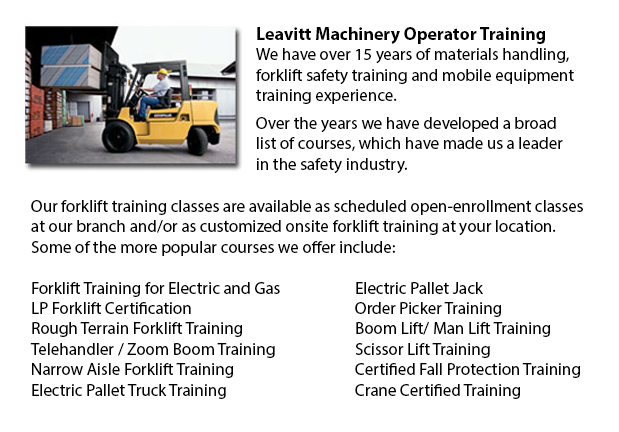
Nanaimo Forklift Training Schools - Forklift Training Schools
If you are searching for work as an operator of a forklift, our regulatory-compliant forklift training Schools offer exceptional instruction in various styles and types of forklifts, lessons on pre-shift check, fuel types and handling of fuels, and safe utilization of a forklift. Hands-on, practical training assists participants in acquiring essential operational skills. Program content includes current regulations governing the operation of lift trucks. Our proven forklift courses are meant to provide training on these types of trucks: counterbalanced forklift, powered pallet trucks and narrow isle forklift.
When the forklift is in use, do not lower or raise the forks. Loads should not extend above the backrest. This is because of the possibility of the load sliding back in the direction of the operator. Inspect for overhead obstructions and make certain there is plenty of clearance prior to lifting a load. Stay away from overhead power lines. Once the load is raised straight up, tilt it slightly back.
The lift truck is less steady when a load is in a raised position. Ensure that no body ever walks underneath the elevated fork. The operator must not leave the forklift when the load is lifted.
The forks must be level when handling pallets, and high enough to extend all the way into and under the load. The width of the forks must provide equal weight distribution.
Chock the wheels and set the brakes prior to unloading and loading the truck. The floors should be strong enough to support the weight of both the load and the forklift. Fixed jacks can be installed to be able to support a semi-trailer that is not coupled to a tractor. The height of the entrance door should clear the height of the forklift by a minimum of 5 cm. Mark edges of ramps, docks or rail cars and avoid them.
-
Nanaimo Boom Lift Certification
Nanaimo Boom Lift Certification - Using elevated work platforms allow for maintenance operations and work to be carried out at elevated work heights which were otherwise not reachable. Workers making use of scissor lifts and boom lifts can learn how... More -
Nanaimo Boom Lift Safety Training
Nanaimo Boom Lift Safey Training - Boom lifts are a kind of aerial lifting device or elevated work platform which are commonly used in industry, warehousing and construction. Boom lifts could be utilized in practically whichever environment because o... More -
Nanaimo Loader Operator Training
Nanaimo Loader Operator Training - Loader Operator Training - Forklift training is a prerequisite within North America and is intended to prevent workplace death and injuries. Lift truck training provides driver training intended for forklift operato... More -
Fall Protection Certification in Nanaimo
There are high numbers of injuries at work associated to falling and lots of fall-related deaths reported each and every year. Most of these instances might have been prevented with better training, better measures in place, and by properly equipping... More -
Nanaimo Crane Ticket
Nanaimo Crane Ticket - The modern version of a crane can be either complex or simple, and cranes vary based on their use. Mobile cranes, for example are rather simple. A telescopic boom or steel truss mounts its movable platform. A system of levers o... More -
Operator Safety Certification | Re-Qualification Certification | In-House Instructor Certification in Nanaimo
Lift trucks are used in practically all industrial construction sites and in warehouse operations and in boat yards. The reach feature of a forklift is a very important part utilized in several applications like when a shelving system is being used t... More -
Aerial Lift / Boom Lift / Man Lift / Scissor Lift Certification in Nanaimo
Scissor hoists are lift tables which lift up materials and individuals and supplies vertically. They are normally used in construction, commercial and industrial environments. A common use of scissor hoists is for lowering or lifting construction sup... More -
Crane / Overhead Crane / Self-Erect Crane / Truck Mounted Crane / Hydraulic Cranes Certification in Nanaimo
Bridge cranes or likewise called overhead cranes are a type of industrial material handling crane utilizing a line and hook apparatus that runs on a horizontal beam running along two widely separated rails. Several overhead cranes can be seen inside... More

Forklift Certification Nanaimo
TOLL FREE: 1-888-254-6157
Nanaimo, British Columbia
forkliftcertificationnanaimo.com
Email Us
About Us


